TDD vs BDD vs ATDD: Which One to Choose?
Enrique
Posted On: April 5, 2024
![]() 647864 Views
647864 Views
![]() 21 Min Read
21 Min Read
When it comes to building high-quality software applications, testing plays a crucial role. Within the Agile development methodology, three key approaches focus on writing clear and effective tests: Test-Driven Development (TDD), Behavior-Driven Development (BDD), and Acceptance Test-Driven Development (ATDD).
TDD, BDD, and ATDD approaches emphasize writing tests before code. TDD focuses on the developer writing tests first, BDD on user behavior, and ATDD on collaboratively defining acceptance criteria. They can be complementary, with the best approach depending on your project and team.
While their names might sound similar, they each have distinct approaches to guide you toward well-developed and test software applications. This blog on TDD vs BDD vs ATDD dives into each approach, explaining how it differs from the others. By understanding these techniques, you can make informed decisions about which testing approach best suits your project’s needs. If you are preparing for an interview you can learn more through BDD interview questions.
TABLE OF CONTENTS
- What is Test-Driven Development?
- Pros and Cons of Test-Driven Development
- How to Implement Test-Driven Development?
- What is Behavior-Driven Development?
- Pros and Cons of Behavior-Driven Development
- How to Implement Behavior-Driven Development?
- What is Acceptance Test-Driven Development?
- Pros and Cons of Acceptance Test-Driven Development
- How to Implement Acceptance Test-Driven Development?
- TDD vs BDD vs ATDD – The Final Showdown
- Can TDD, BDD, and ATDD Work Together?
- TDD vs BDD vs ATDD – Which One to Choose?
- Frequently Asked Questions (FAQs)
What is Test-Driven Development?
Test-Driven Development is a programming practice implemented from a developer’s perspective. In this process, a QA engineer begins designing and writing test cases for every small functionality of an application.
This technique tries to answer a simple question: Is the code valid? The primary purpose of this practice is to modify or write new code only when the tests fail. Consequently, it results in less duplication of test scripts. This technique is mainly popular in Agile development ecosystems. In an ATDD approach, test scripts are written before functional pieces of code.
Pros and Cons of Test-Driven Development
TDD is a test-first practice, where automated test scripts are typically written before implementing the product’s actual features. However, TDD has its following pros and cons.
Pros of Test-Driven Development:
- Reduced development cost: The development process in TDD is split into smaller chunks to facilitate the detection of issues at the early stages of design and development.
- Focus on design and architecture: Writing tests before the implementation makes the development process more seamless and efficient.
- Improved code coverage: A well-designed system can achieve 100 percent code coverage through TDD.
- Code visibility: Tests are written to verify minor functionalities, making refactoring and maintaining the code easy.
- Detailed documentation: Since tests are written to verify micro-level functionalities, writing documentation becomes easy.
Cons of Test-Driven Development:
- Bugs leading to faulty code: Tests could contain bugs, resulting in faulty implementation. This can be averted by using the right BDD framework, performing detailed code review, and more.
- Costly architectural issues: If the generated test code is not in line with the desired architecture, it could result in huge losses.
- Slowness in development: Creating test cases before code development slows product development. In addition, framing test cases may take a huge time as the actual implementation is not available at that time.
- Requires prior experience: Prior experience with TDD is a must since many teams commit the mistake of not running tests at the red phase.
Adopting TDD, BDD, or ATDD can greatly enhance the quality of your software by encouraging early testing and collaboration. However, creating and maintaining test cases can often be time-consuming and complex. This is where AI test assistants such as KaneAI can help.
KaneAI by LambdaTest is a GenAI native end-to-end AI software testing assistant designed with industry-first features for test authoring, management, and debugging, tailored specifically for high-speed quality engineering teams. Built from the ground up, KaneAI empowers users to create and refine complex test cases using natural language, dramatically reducing the time and expertise needed to begin test automation.
How to Implement Test-Driven Development?
Test-Driven Development prefers testing instead of the implementation phase. As all the tests pass, it signals the end of the first iteration. However, if more features have to be implemented, all the phases must be repeated with new feature tests.
The diagram below summarizes the flow of TDD:
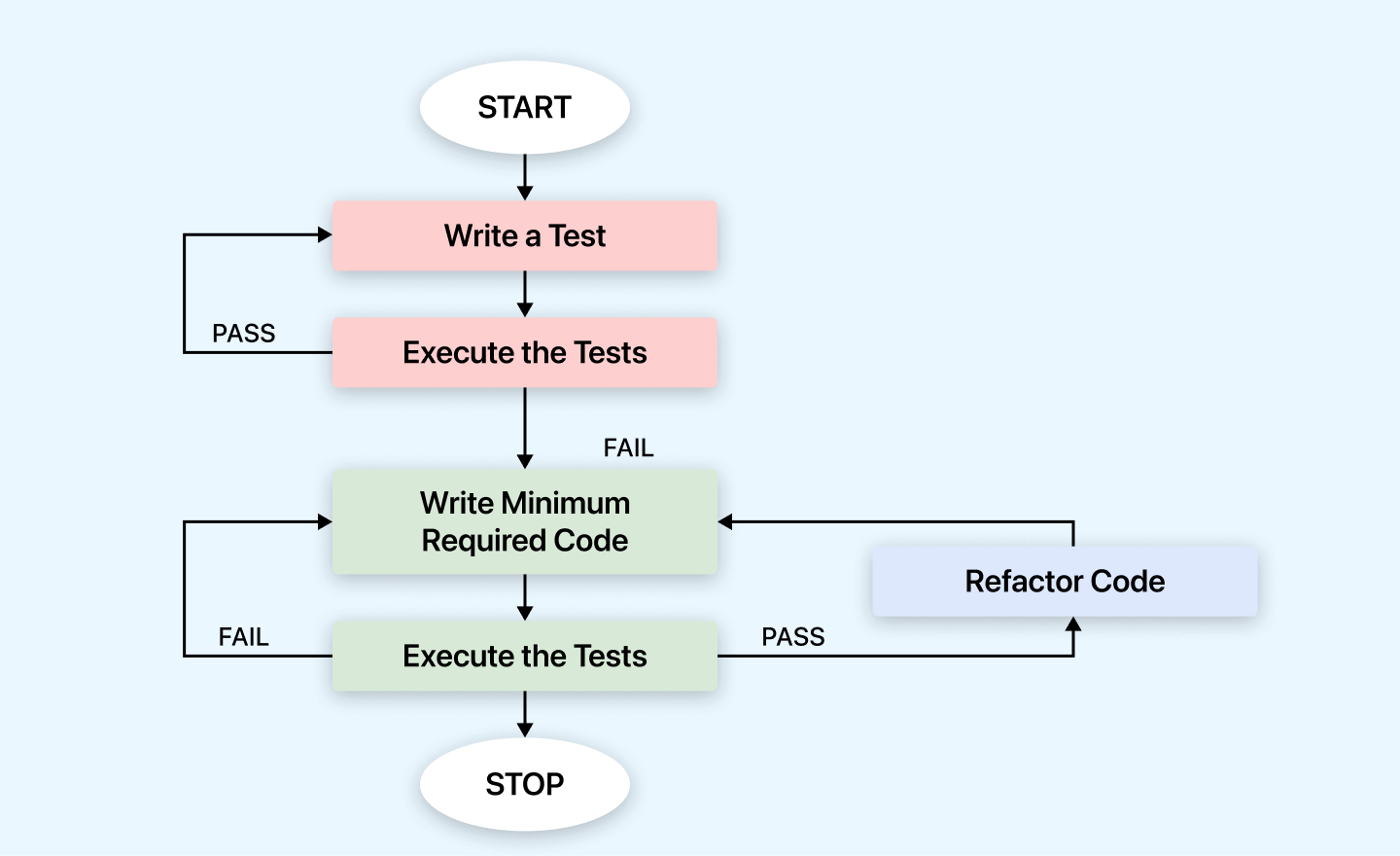
- Write a test: First, you create a test focusing on a small part of the feature you want to add to your project. The trick here is that you write the test in a way that is expected to fail because you haven’t built that feature yet. So, when it fails, it’s called a failing test or the red phase.
- Execute the tests: Next, you actually run the test you just wrote. Since you haven’t built the feature yet, the test will fail, just as you predicted. This confirms that your test is working as expected.
- Write minimum required code: You start writing the minimum code needed to make that failing test pass. The goal isn’t to create a perfect or fully-featured solution but just enough to satisfy the test and turn its status from red to green.
- Run the tests again: After writing the code, you run the test again. If it passes this time, you’ve successfully built the basic functionality required by the test. Your test is now green, indicating success.
- Refactor code: With the test passing, you can step back and tidy up your code. This means making it more efficient, readable, and organized without changing its behavior. After refactoring, you run your tests again to ensure everything works as expected. This step ensures that your improvements don’t introduce any new issues.
- Repeat: This cycle doesn’t end here. You continue by writing more tests, writing the minimum code to pass them, and then refactoring. Each iteration adds a bit more functionality to your project until you’ve either implemented the entire feature or achieved the desired level of coverage.
In this blog on TDD vs BDD vs ATDD, we have covered what TDD is, including its advantages and disadvantages. In the next section, we will look into BDD.
What is Behavior-Driven Development?
Behavior-Driven Development is derived from the Test-Driven Development methodology. In BDD, tests are based on systems behavior. The BDD approach describes different ways to develop a feature based on its behavior. In most cases, the Given-When-Then approach is used for writing test cases.
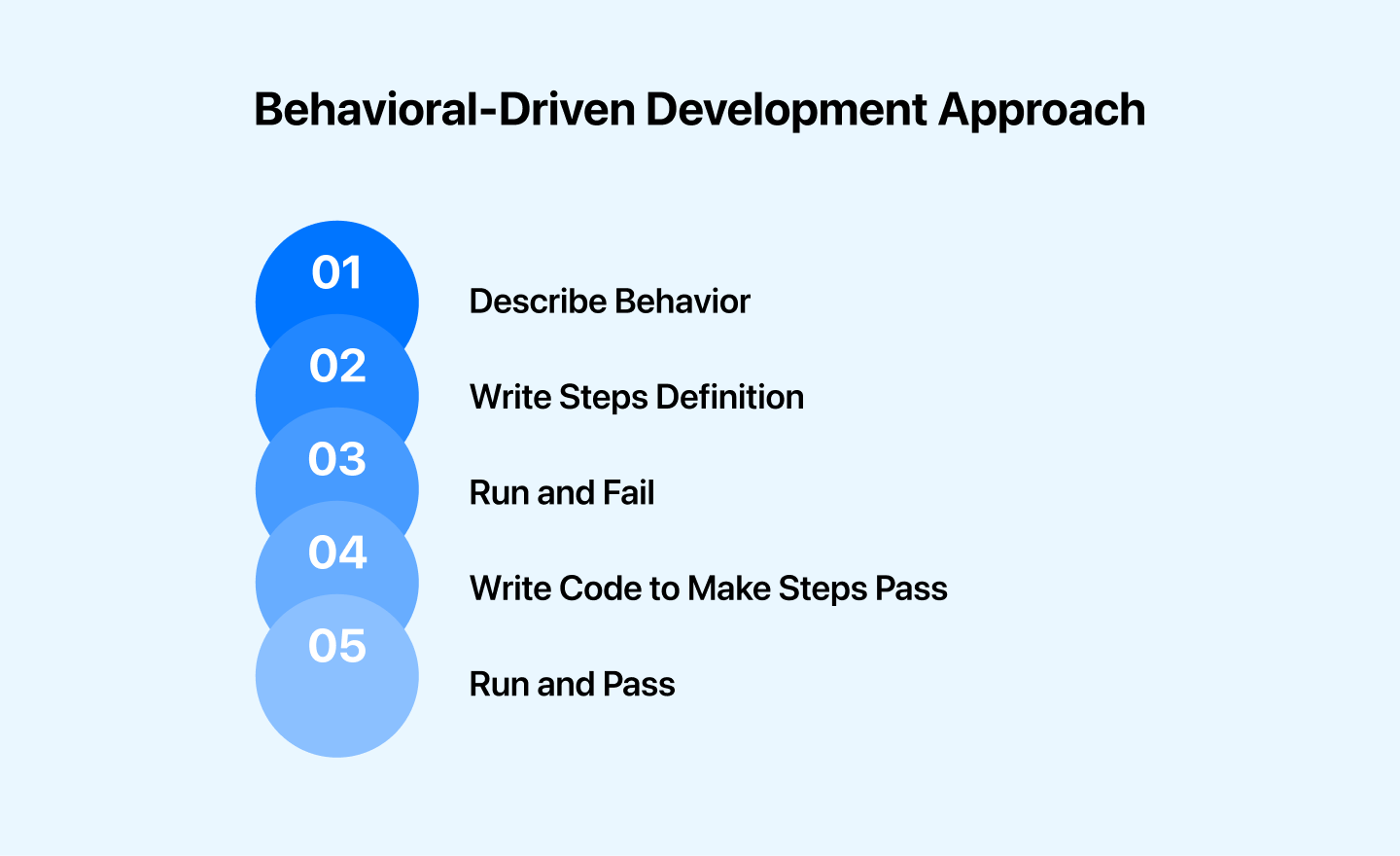
Let’s take an example for better understanding:
Scenario: User successfully signs in
- Given the user is on the login page.
- When the user enters a valid username, “johnduo123” and password.
- And the user submits the login form.
- The user should be redirected to the home page.
- The user should see the welcome message “Welcome, johnduo123”.
Debugging the errors in the latter stages of the development life cycle often proves very expensive. In most cases, ambiguity in understanding the requirements is the root cause. Therefore, one must ensure that all the development efforts remain aligned toward fulfilling pre-determined requirements. BDD allows developers to do the above by:
- Allowing the requirements to be defined in a standard approach using simple English.
- Providing several ways to illustrate real-world scenarios for understanding requirements.
- Providing a platform enables the tech and non-tech teams to collaborate and understand the requirements.
Pros and Cons of Behavior-Driven Development
BDD is an approach that involves managers, testers, developers, etc., in the whole process. As a result, BDD offers a huge number of benefits. Let’s look at some of the major ones in this section.
Pros of Behavior-Driven Development:
- Improved communication: Creating scenarios requires close coordination between customers, managers, developers, testers, etc. This unifies the team in understanding the product behavior.
- Reduced cost of quality control: Automated acceptance tests are used to depict the scenarios, which in turn helps in reducing the costs involved in inspecting the software quality.
- Accurate task estimation: Since the expected behavior is predicted before, there are few chances to change the software application’s architecture.
- Better user experience: The scenarios and tests written before development consider the user’s perspective. The focus is on the desired behavior rather than on implementing features.
- Excellent documentation: When a certain test fails, the specification is updated, resulting in detailed documentation.
Cons of Behavior-Driven Development:
- BDD tools struggle with parallelization: Cucumber and SpecFlow do parallelization or support parallel testing in a sub-optimal manner. They parallelize at the feature file level. It implies that if you want to run 50 tests in parallel, you need to have 50 feature files. That’s a lot of feature files.
- Writing incorrect Gherkin syntax: The issue is that most of us do not follow the correct Gherkin syntax as prescribed by the BDD creators. Remember that Given-When-Then steps must appear in order and cannot be repeated.

You can also Subscribe to the LambdaTest YouTube Channel and stay updated with the latest tutorials around Selenium, automated testing, and more.
How to Implement Behavior-Driven Development?
As we know, BDD is an extension of TDD. BDD plays a crucial role in cutting back the bugs and errors you would encounter at later stages of product development. Effective test automation strategy, including scenarios, can be developed by involving different teams (e.g., engineering, product management, marketing, etc.).
The BDD approach allows technical and non-technical teams to collaborate on knowledge and ideas. It’s time for some action.
Cucumber is a framework that supports BDD; anyone can write specifications in plain English using Gherkin. It is as simple as adding a test from the business value point of view, as I like to call business-centric test automation.
If you are new to Cucumber, you can also check out the step-by-step tutorial on Selenium Cucumber with examples.
Let’s add the Cucumber plugin using npm to our current Cypress project.
- Install the cypress-cucumber-preprocessor plugin.
- The following dependency with the latest version will be added to your package.json of the project. At the time of writing this blog on TDD vs BDD vs ATDD, the version of cypress-cucumber-preprocessor is 4.3.1.
- Add the downloaded plugin to cypress as part of Cypress Configuration under cypress.config.js file.
- Next, add cosmiconfig to the package.json. The cosmiconfig searches and loads the required configuration of the project. In this case, we are defining to locate the step definitions.
- Create a new folder under Cypress > Integration directory as cucumber-test and then create a new feature, Home.feature.
- For step definition location, create a folder named home. Now, create a step definition file homeSteps.js.
- Now, let’s run using the following command in the terminal or command console to execute the test:
- On Cypress Test Runner, select homeSteps.
- Feature
- Scenario
- Scenario Outline
- Background
- Exploring and examining real-world scenarios.
- Selecting the acceptance criteria for those test scenarios.
- Automating the acceptance of test cases.
- Focusing on the development of those use cases.
- Streamlined Collaboration: Foster clear communication between users and developers, ensuring everyone is on the same page.
- Crystal-Clear Requirements: Gain a deeper understanding of user needs early on, leading to the development of the right features and functionalities.
- Evolving Requirements and Testing: Continuously refine your development requirements and test cases based on user feedback, prioritizing what truly matters to your customers.
- Learning curve: Teams unfamiliar with the technique may find the collaborative aspect of ATDD, which involves non-technical stakeholders, to have a steeper learning curve.
- Time required: The extensive scope of end-to-end testing in ATDD can be time-consuming, slowing development.
- Availability of stakeholders: Delays in the stakeholders’ availability may impact the development process, as ATDD depends on ongoing engagement with them.
- Discuss: This step is about what the customer wants. It means understanding what the end product should look like from the customer’s perspective. Testers and developers sit with the customers, owners, or others involved in the project to review the details and requirements of the proposed features.
- Distill: Here, the focus is on converting the tests into a format the test tool can easily work with. It’s like translating the simple English tests into a language the system can understand. This makes it easier to integrate the tests into the development process.
- Develop: This stage is where the actual building of the features happens. ATDD follows a test-first development approach here. This means writing and ensuring the test code before actually implementing the features. Developers only build the features after going through the discussion and distillation stages and ensuring the tests run smoothly. This process continues until the tests pass successfully.
- Demo: Once all the required features are implemented, developers showcase a demonstration to the business stakeholders. It’s a way of showing them what has been built and how it works.
The folder structure should look like this:
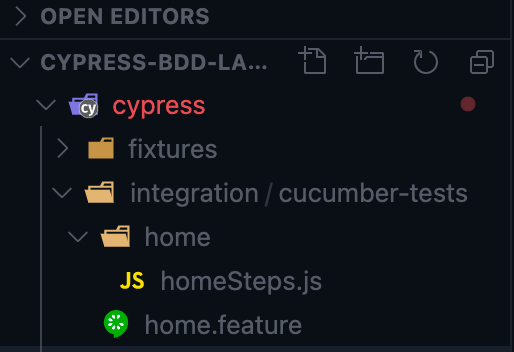
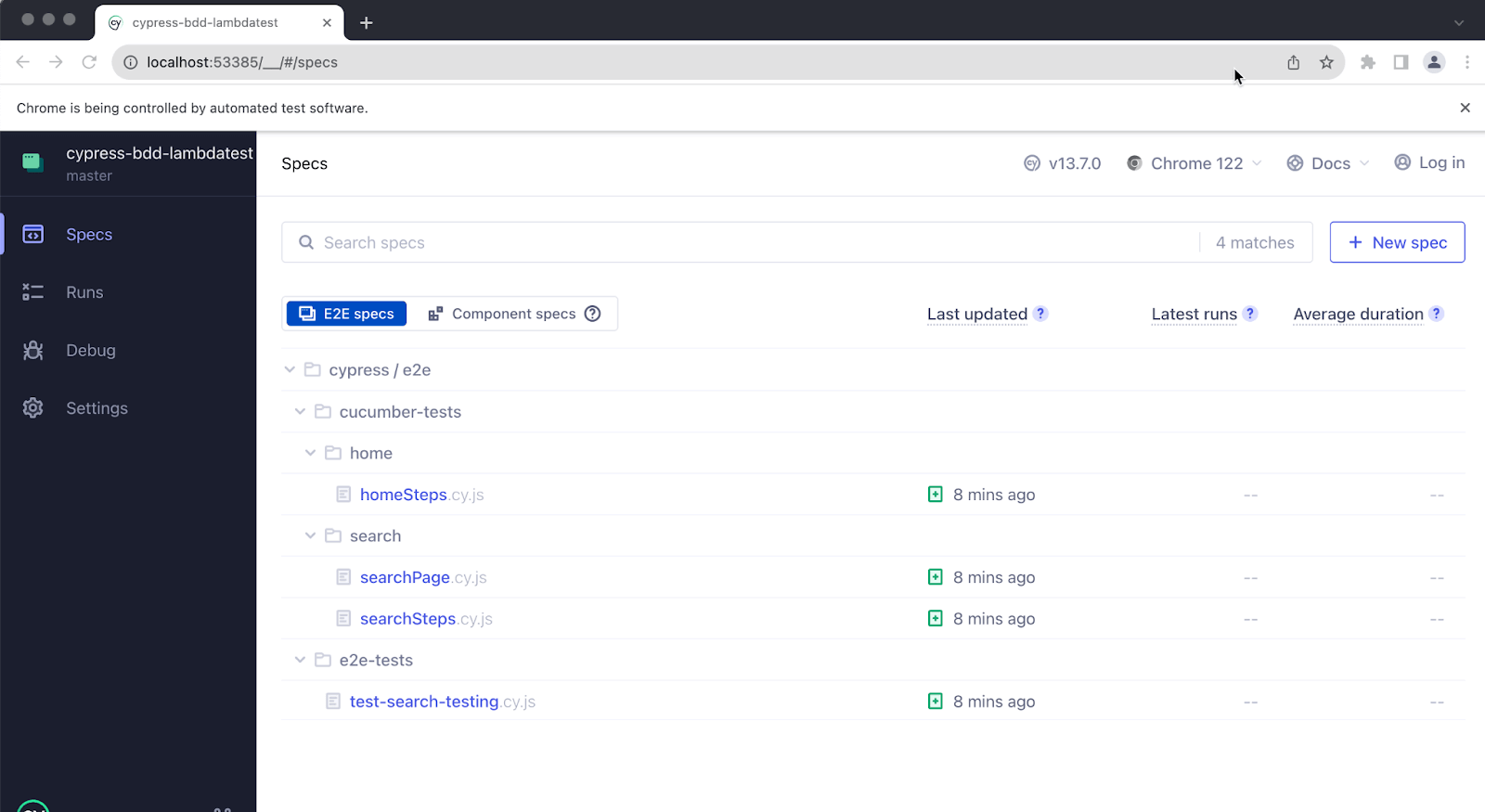
And you should see the results:
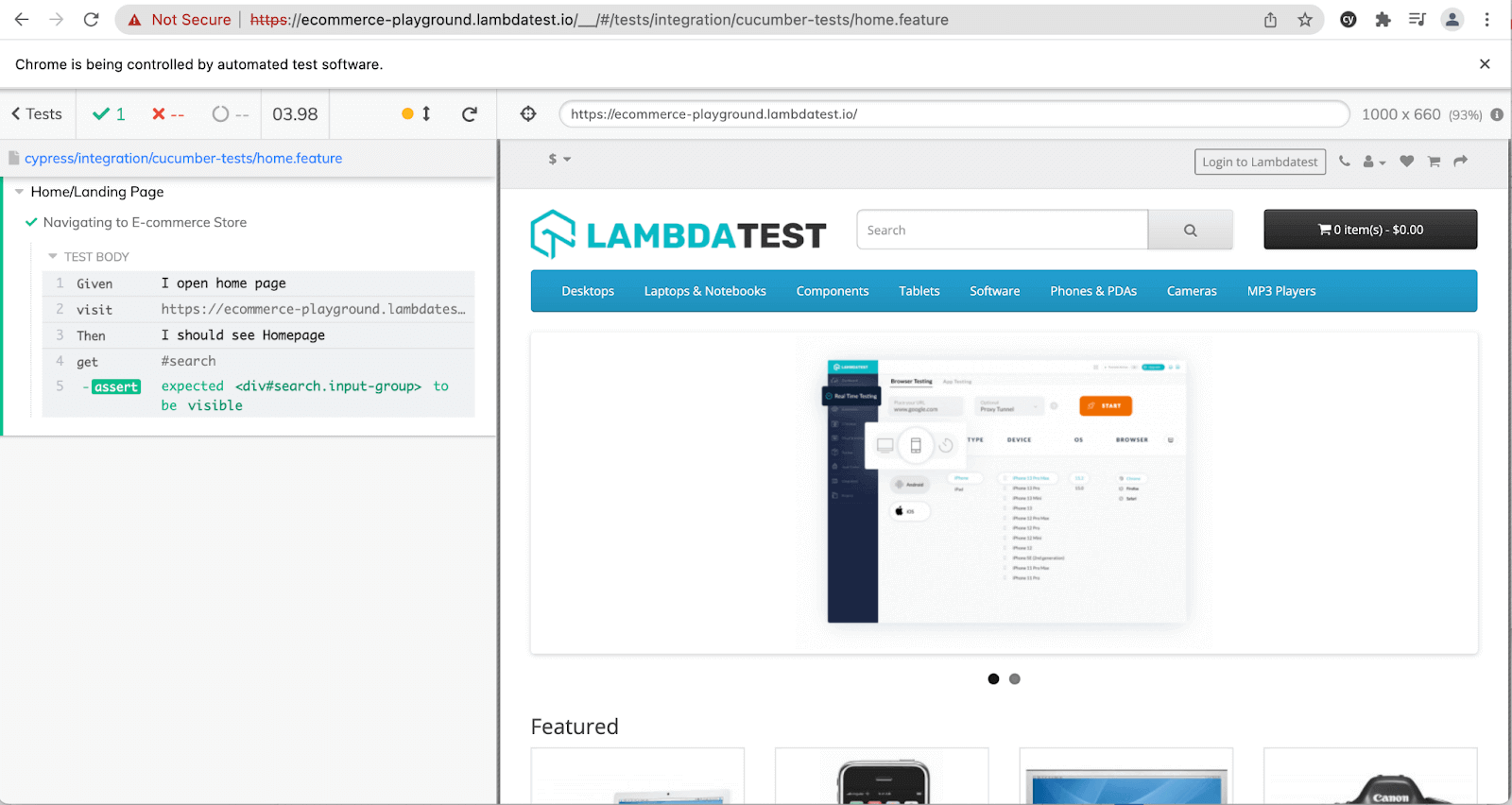
Gherkin Keywords
Keywords are used to give structure and meaning to the executable specifications. Every specification or a feature file starts with one of the keywords:
Feature: It is the primary key in the Gherkin; it is used to describe the specification name.
Scenario: It is the collection of actions or steps that need to be performed to fulfill a test objective.
Scenario Outline: It is used when the same scenario needs to be executed with multiple data sets. Scenario Outline is always defined with the Examples keyword. That’s where data sets can be defined to execute the same scenario multiple times. Scenario Outline is used for data-driven tests.
Implementation Example:
Background: It is used to define a step or series of steps common to all the tests included in the feature file. The steps defined as part of the background get executed before each scenario. Adding the Background section is helpful to avoid duplication of feature steps.
In this blog on TDD vs BDD vs ATDD, we have covered TDD and BDD so far, including their advantages and disadvantages. In the next section, we will look into ATDD.
What is Acceptance Test-Driven Development?
In the Acceptance Test-Driven Development technique, a single acceptance test is written from the user’s perspective, mainly focusing on satisfying the system’s functional behavior. ATDD extends TDD by focusing on meeting the business requirements before writing code.
ATDD is a collaborative approach involving developers, testers, and business stakeholders. The following are some of the critical practices in ATDD:
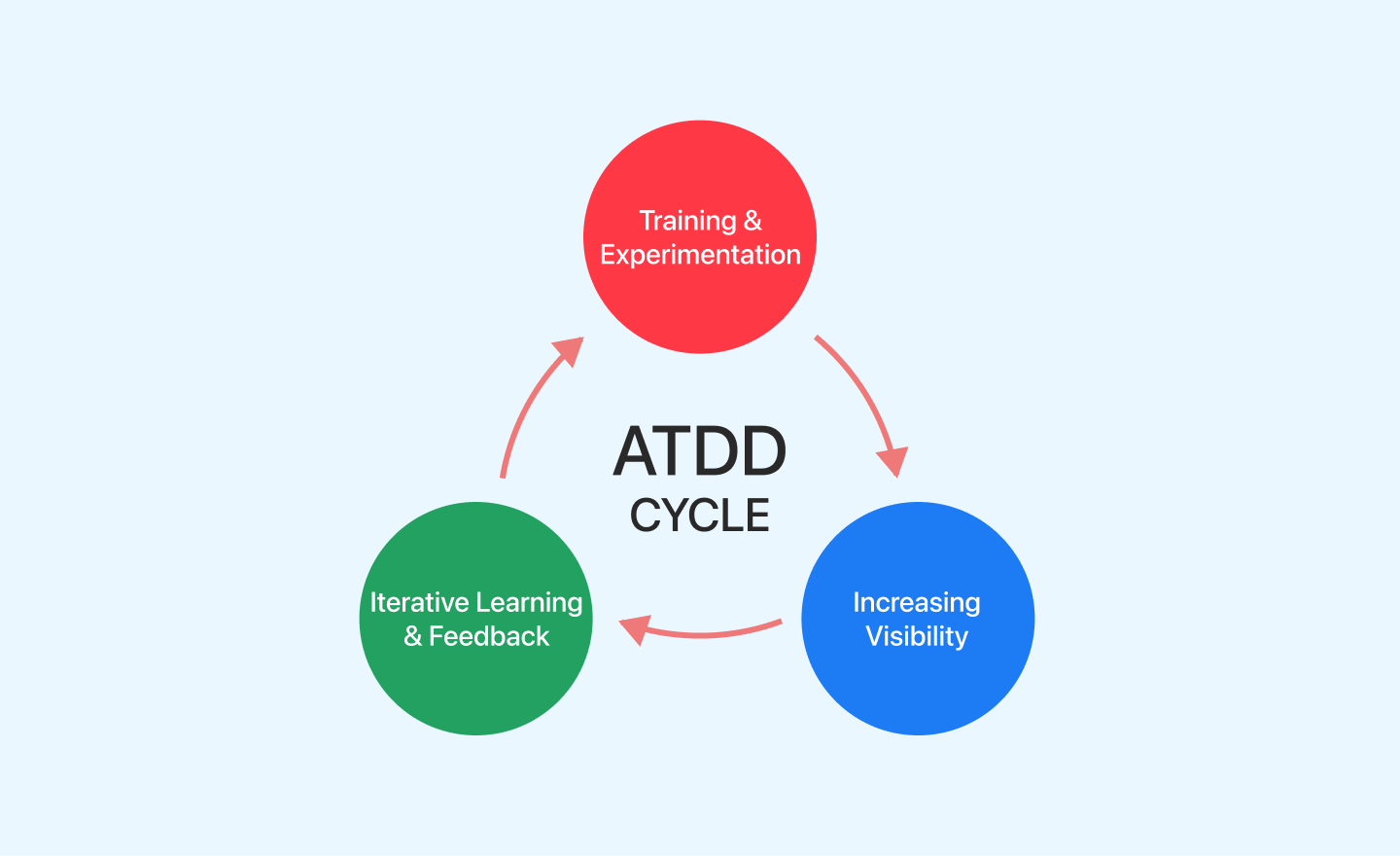
Pros and Cons of Acceptance Test-Driven Development
In ATDD, collaboration takes place with stakeholders to determine acceptance criteria for new features, like special promotions, loyalty programs, or integration with third-party payment gateways. However, ATDD has a bunch of pros and cons.
Pros of Acceptance Test-Driven Development:
Cons of Test-Driven Development:
How to Implement Acceptance Test-Driven Development?
In simple terms, there isn’t a fixed way to go about using the ATDD cycle, but generally, it involves four main steps that are common across different ATDD approaches:
For instance, consider that we’re developing a new flight booking feature. First, we define the acceptance criteria with the stakeholders:
The user should be able to select flight dates. The system should display available flights for the selected dates.
Based on these criteria, we write the acceptance tests (before the development starts):
The development team ensures these tests pass and align closely with the business requirements.
TDD vs BDD vs ATDD – The Final Showdown
TDD vs BDD vs ATDD is a quest for some developers. Even experienced developers need help to differentiate between these approaches. Now that we have touched upon the working and implementation of TDD vs BDD vs ATDD. let’s look at the major differences between TDD vs BDD vs ATDD.
| Criteria | Test-Driven Development | Behavior-Driven Development | Acceptance Test-Driven Development |
|---|---|---|---|
| Language | Test cases designed in TDD are technical. These are similar to the test cases normally written during the testing phase. | The test scenarios designed in BDD are written in simple English language. | The acceptance criterias are written in simple English language. |
| Implementation Level | There is a low-level implementation in TDD. | The scenarios are easy to understand and implement, making BDD a high-level implementation with regard to test case development. | The acceptance criteria are easy to understand and implement. |
| Key Stages | Test case development is the major phase in TDD. | Discussion and creation of scenarios are the major stages in BDD. | Writing acceptance tests is the major phase in ATDD. |
| Stages Involved in Development | TDD involves three main stages, test creation, implementation, and code refactoring are the major stages in TDD. | BDD involves a number of stages like feature discussion, scenario creation, testing, implementation, and code refactoring. | ATDD involves a number of stages like feature discussion, acceptance criteria creation, testing, implementation, and code refactoring. |
| Participants | Only technical teams, like development teams, take part in TDD processes. | BDD involves teams, from customers to business analysts, testers, developers, etc. | ATDD involves teams, from business analysts, testers, developers, etc. |
| Primary Focus | Development of required functionality based on test cases is the primary focus of TDD. | BDD focuses on the correspondence between implemented features and expected behavior. | ATDD focuses on writing acceptance tests. |
| Documentation | TDD requires documentation for the creation of accurate test cases. | Emphasis is laid on documentation created during the scenario creation process. | ATDD requires documentation for the acceptance criteria. |
| Tools | The tools (or frameworks) used in TDD involve JUnit, TestNG, NUnit, etc. These are used to run test cases. | Gherkin is used for writing scenarios in BDD. Cucumber, SpecFlow, etc., are widely used test automation frameworks. | TestNG, FitNesse, Specmore, Concordion, Thucydides, Robot |
| Applicable Domain | The main focus in TDD is to get appropriate functionality through implementation. | BDD has the defined domain as “Behavior.” This focuses on the product’s behavior at the end of implementing the product functionality. | The main focus in ATDD is to get appropriate functionality through pass or fail acceptance criteria. |
| Bug Tracking | Bug tracking is easier in TDD, as the tests indicate whether they have passed or failed. | Bug tracking in BDD requires integration between multiple tools across the organization. | Bug tracking is easier in ATDD, as the tests indicate whether they have passed or failed. |
So, these were the key differences as far as TDD vs BDD vs ATDD is concerned. So, make sure to look at these differences when you have to decide between TDD vs BDD vs ATDD.
Can TDD, BDD, and ATDD Work Together?
So far, we have seen what is different as far as TDD vs BDD vs ATDD is concerned. The best part is that these processes are not mutually exclusive. While it’s not unusual for Agile development teams to use one without the other, making these two work together can ensure a higher degree of efficiency in testing use cases, thereby bringing confidence in the performance.
TDD, when used alongside BDD, gives importance to web testing from the developer’s perspective, emphasizing the application’s behavior. Developers can create separate testing units to implement the specifics to get robust components. This is beneficial since the same component can be used in different places across the software development process.
The combination of ATDD and BDD frameworks can add more value to the software development process. This is where cloud-based testing platforms like LambdaTest can be beneficial since they can be integrated with major TDD and BDD frameworks.
LambdaTest is an AI-powered test orchestration and execution platform using which developers and testers can leverage the capabilities of TDD, BDD, and ATDD frameworks and perform automation testing at scale on a remote test lab of 3000+ real browsers, devices, and operating systems.
LambdaTest Integrations with tools like Slack, Microsoft Teams, etc., make discussions between the teams efficient and easy. TDD, BDD, or ATDD, the choice is governed by the individual needs of an application or the enterprise.
 Note
NoteAutomate your test suites on the online Selenium Grid. Try LambdaTest Today!
TDD vs BDD vs ATDD – Which One to Choose?
BDD, TDD, and ATDD have differences and similarities. Although, at the same time, it’s not unusual for Agile teams to use one without the other, making the two work together can guarantee a higher degree of efficiency in testing application use cases, thus obtaining greater confidence in their performance.
For instance, an Agile team, alongside TDD, can use the BDD approach to implement a higher level of testing that takes care of technical nuances from the Agile team’s point of view, assesses the application’s behavior, and finally applies ATDD to align the final product with the overarching business goals.
To implement the specifics, we can create separate testing units to maintain the robustness of different components. It can be beneficial because the same component can be used in other places across an application.
The testing process is based on specifying test scenarios in simple language. Then, automation engineers add TDD parts to test certain specific components. Whether to choose BDD/ATDD over TDD or use a combination of the three methods is a choice ruled by the needs of an application or organization.
Experimenting with BDD and ATDD if you’re already doing TDD testing can add value to the Agile process. Using the three together is more accessible, and you don’t need to change or rework the existing approach. All it takes is updating the testing framework to adjust the other.
Final Thoughts
The main idea of TDD, BDD, and ATDD is not about selecting one over the others; it’s about understanding which methodology, or a combination thereof, best suits the current phase of your project and the specific challenges you face. By applying these methodologies judiciously, you can build technically sound software that satisfies users and achieves business goals. This blog on TDD vs BDD vs ATDD should provide practical guidelines to help you make these strategic decisions, leading to more successful projects and satisfied stakeholders.
Frequently Asked Questions (FAQs)
What is the difference between ATDD, BDD, and TDD?
ATDD, BDD, and TDD all start with tests, but the target differs. TDD focuses on unit tests for clean code, ATDD on user stories for collaboration, and BDD on user behavior for clear communication.
What is BDD and TDD difference between them?
BDD and TDD write tests first but for different purposes. BDD focuses on user behavior (what the app does), while TDD targets code quality (how the code works). BDD starts with user stories, while TDD starts with specific functions.
Is Agile based on BDD or TDD?
Agile is a methodology for software development that emphasizes iterative development, flexibility, and collaboration. It’s not inherently based on a specific testing approach like BDD or TDD. However, BDD fits with user stories and collaboration in Agile, while TDD aligns with Agile’s iterative cycles. Teams can choose the best fit.
Got Questions? Drop them on LambdaTest Community. Visit now
















